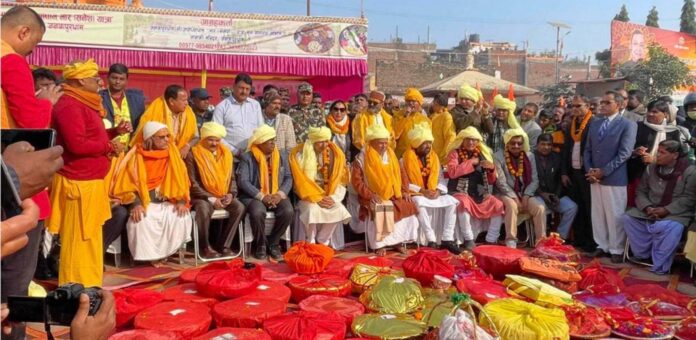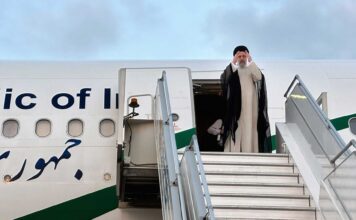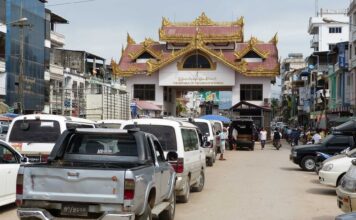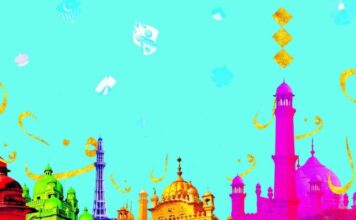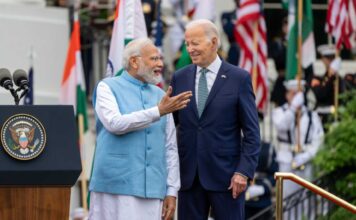A 500-member procession arrived in Ayodhya with several wedding gifts for Lord Ram on behalf of Janakpur, the birthplace of Goddess Sita.
Bhars, as it is called locally, are baskets that contain lots of wedding gifts, including jewelry, gold and silver items, dry fruits, utensils, garments, cosmetics and quintals of grains, all of which are given to a bride when she gets married.

“Since Sitaji was from Janakpur, we carried all this to Ayodhya as an offering to Lord Rama on January 6, ahead of the inauguration of Ram Temple on January 22,” said Lalit Shah, member secretary of the Janakpurdhamash Ayodhyadham Bhar Yatra, a committee which organized the visit.
Ayodhya’s local authorities made arrangements for hosting around 251 people from Nepal.
Janaki Temple, Janakpur

250,000 lamps were lit in Janakpur in the occasion
The Janaki Temple in Janakpur Nepal, dedicated to the goddess Sita, was decorated with colorful lights and over 2.5 lakh oil lamps to commemorate the Ram Mandir Pran Pratishtha in Ayodhya. Janakpur is known as the native place of Sita and glowed with festivities in the run up to the Pran Pratisha.
Sita’s other name is Janaki, daughter of King Janak of Janakpur. It is 220 kms southeast of Kathmandu and about 500-odd km east of Ayodhya. Tapeshwar Das, the chief priest of the Janaki Temple at Janakpur, described the Ayodhya event as the meeting of two families, the families of Lord Ram and Mata Sita.” More than 3,000 gifts have been sent to Ayodhya, including silver shoes, ornaments, and dresses from Janakpur, he added.
The celebrations in Nepal took place mainly in eight districts in Madhesh province — Dhanusha, Mahottari, Sarlahi, Siraha, Saptari, Bara, Parsa and Rautahat.
Janaki temple in the city of Janakpurdham was decked up for the Ram Temple consecration ceremony. Sarlahi district also participated in the celebrations with religious processions and prayers at major temples.
Nepal is situated between India and China. Both India and China have an influence on Nepal and vice versa. However, in comparison, India has a deep cultural, geographical, and political connection with Nepal, he said. India and Nepal enjoy ’roti-beti’ relations – trade and marriage, but the same does not apply to China.
The entire Janakpur was reportedly echoed with Ram Bhajans and rangolis were made on the roads. A big TV screen was installed in the temple premise for people to watch the live consecration of Ramlalla in Ayodhya.
According to Hindu beliefs, Lord Ram and Sita were married in Janakpur on the fifth day of Shukla Paksha of Margasira month in Treta Yug commemorated as ‘Vivah Tithi Panchami‘.
Locals are happy as they expect a spike in religious tourism in Janakpur after Ram temple consecration. Janakpur Dham got a new lease of life after Prime Minister Narendra Modi and Uttar Pradesh Chief Minister Yogi Adityanath’s visit. Many Indian tourists started visiting this place. After Ram Mandir’s inauguration, locals are sure, more religious tourists will throng this place.
—————————————————
South Korea recalls ‘Ayodhya connect’
South Korea on Tuesday congratulated India on the grand opening of the Ram Mandir in Ayodhya, while highlighting the ancient ties between the two nations that are deeply rooted in the temple town.
“Congratulations on the consecration ceremony of the RamTemple in Ayodhya,” the Korean Embassy in India said in a post on X, adding that the “place holds a great symbolic importance for Korea-India relations based on the matrimonial link between Queen Sriratna (Heo Hwang-ok) from Ayodhya and King Kim Suro from Gaya (Korea) in 48 A.D.”
Legend has it that Queen Heo Hwang-ok, also known as Princess Suriratna, was the princess of Ayodhya before she married King Kim Suro of Karak Clan in 48 AD. This matrimonial link is celebrated as a cornerstone of the friendly relations between the two countries.

Queen Heo Hwang-ok’s story is chronicled in the ancient Korean text “Samguk Yusa,” which recounts King Suro’s wife as a princess from the distant kingdom of Ayuta, widely believed to be today’s Ayodhya.
At 16 years of age, the princess is believed to have taken a long sea voyage to Korea with her brother Monk Jangyu from the ancient land of ‘Ayuta’ to marry Kim Suro, the king of Geumgwan Gaya in south-eastern Korea.
To honor the queen’s legacy, Prime Minister Narendra Modi and former South Korean President Moon Jae-in signed an MoU in 2015 to expand the memorial during PM Modi’s visit to South Korea. The beautified memorial park was inaugurated in 2022.
The queen’s memorial, first established in Ayodhya in 2001, stands as a testament to this shared history.


